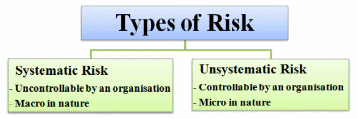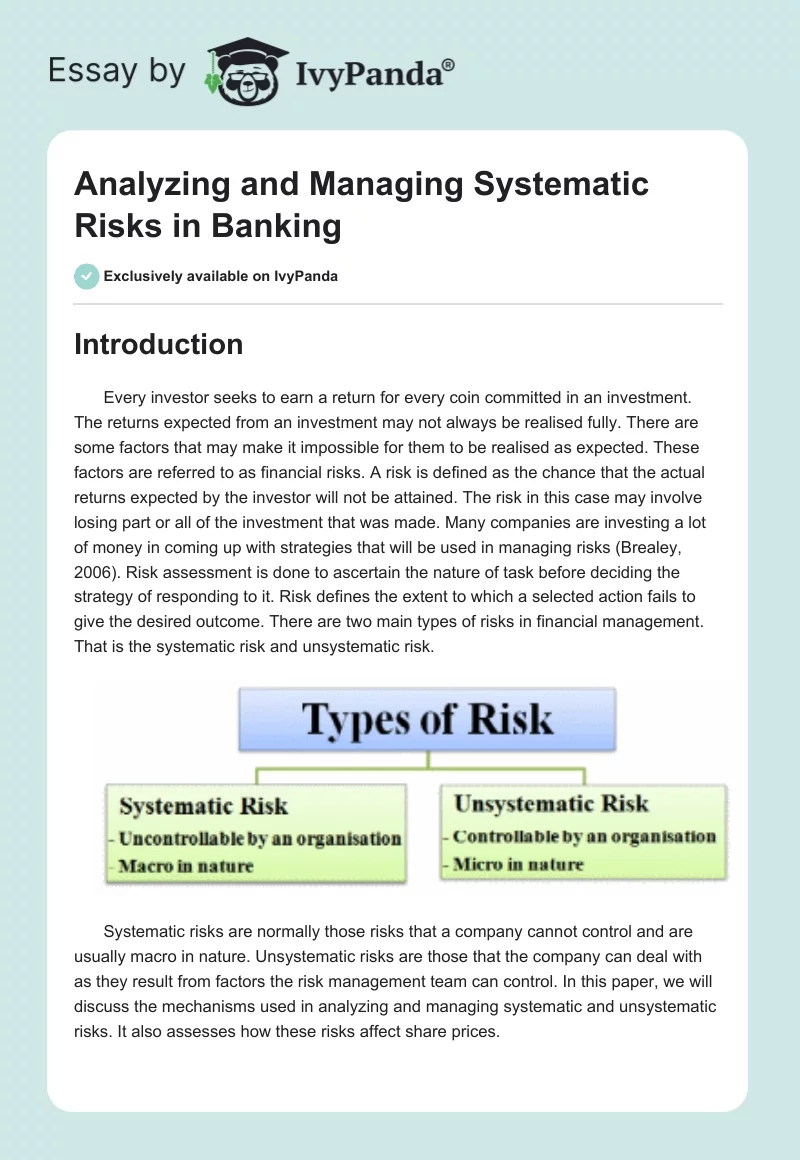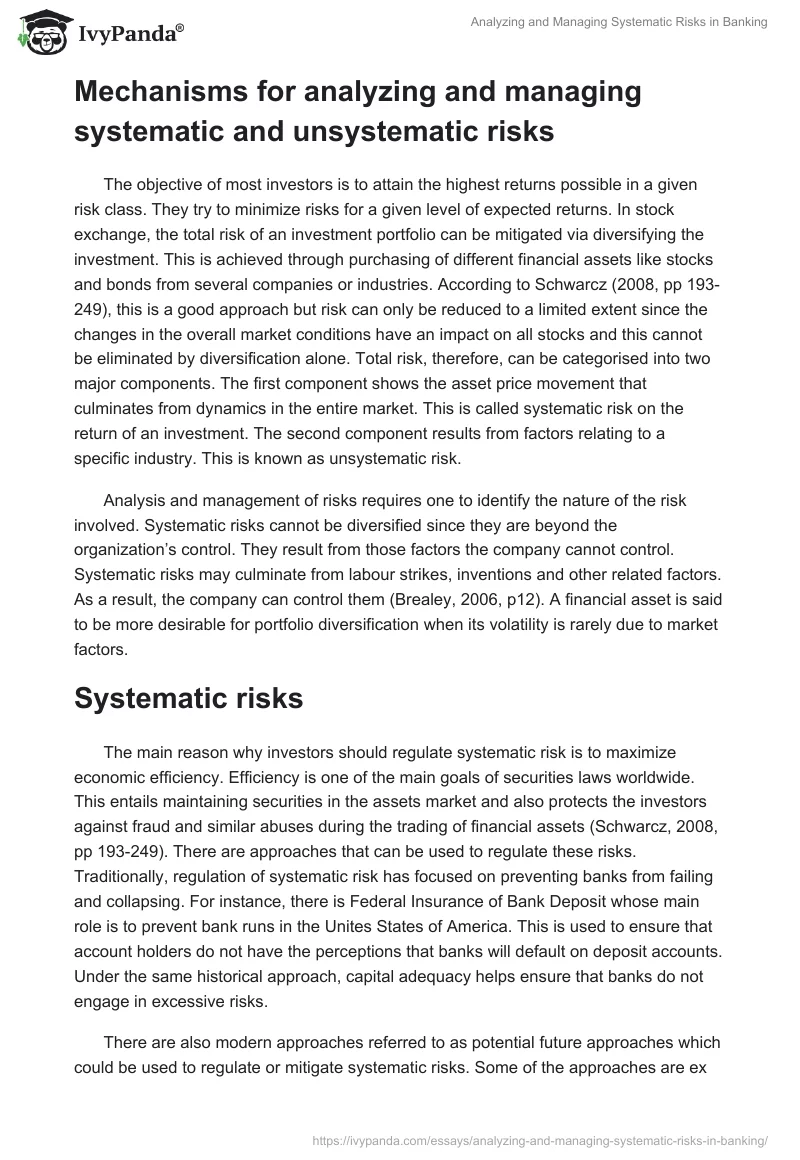Introduction
Every investor seeks to earn a return for every coin committed in an investment. The returns expected from an investment may not always be realised fully. There are some factors that may make it impossible for them to be realised as expected. These factors are referred to as financial risks. A risk is defined as the chance that the actual returns expected by the investor will not be attained. The risk in this case may involve losing part or all of the investment that was made. Many companies are investing a lot of money in coming up with strategies that will be used in managing risks (Brealey, 2006). Risk assessment is done to ascertain the nature of task before deciding the strategy of responding to it. Risk defines the extent to which a selected action fails to give the desired outcome. There are two main types of risks in financial management. That is the systematic risk and unsystematic risk.

Systematic risks are normally those risks that a company cannot control and are usually macro in nature. Unsystematic risks are those that the company can deal with as they result from factors the risk management team can control. In this paper, we will discuss the mechanisms used in analyzing and managing systematic and unsystematic risks. It also assesses how these risks affect share prices.
Mechanisms for analyzing and managing systematic and unsystematic risks
The objective of most investors is to attain the highest returns possible in a given risk class. They try to minimize risks for a given level of expected returns. In stock exchange, the total risk of an investment portfolio can be mitigated via diversifying the investment. This is achieved through purchasing of different financial assets like stocks and bonds from several companies or industries. According to Schwarcz (2008, pp 193-249), this is a good approach but risk can only be reduced to a limited extent since the changes in the overall market conditions have an impact on all stocks and this cannot be eliminated by diversification alone. Total risk, therefore, can be categorised into two major components. The first component shows the asset price movement that culminates from dynamics in the entire market. This is called systematic risk on the return of an investment. The second component results from factors relating to a specific industry. This is known as unsystematic risk.
Analysis and management of risks requires one to identify the nature of the risk involved. Systematic risks cannot be diversified since they are beyond the organization’s control. They result from those factors the company cannot control. Systematic risks may culminate from labour strikes, inventions and other related factors. As a result, the company can control them (Brealey, 2006, p12). A financial asset is said to be more desirable for portfolio diversification when its volatility is rarely due to market factors.
Systematic risks
The main reason why investors should regulate systematic risk is to maximize economic efficiency. Efficiency is one of the main goals of securities laws worldwide. This entails maintaining securities in the assets market and also protects the investors against fraud and similar abuses during the trading of financial assets (Schwarcz, 2008, pp 193-249). There are approaches that can be used to regulate these risks. Traditionally, regulation of systematic risk has focused on preventing banks from failing and collapsing. For instance, there is Federal Insurance of Bank Deposit whose main role is to prevent bank runs in the Unites States of America. This is used to ensure that account holders do not have the perceptions that banks will default on deposit accounts. Under the same historical approach, capital adequacy helps ensure that banks do not engage in excessive risks.
There are also modern approaches referred to as potential future approaches which could be used to regulate or mitigate systematic risks. Some of the approaches are ex ante preventative; others are prophylactic and meant to reduce the systematic risk of collapse. Other approaches are taken when the risk has already occurred. These are ex post reactive and are aimed at mitigating the spread of the risks and their consequences.
Approach of averting Panics
Regulatory approach to risk is meant to eliminating the risk of systematic collapse of an investment project. This goal is theoretically met through preventing financial panics. Mostly, financial panics play a big role in failures of organizations and should be protected as soon as their occurrence is stipulated. This approach is termed as monetarist approach by economists since it is used to identify systematic risks with banking panics that usually causes monetary contraction. The approach, mostly applied by banks, is used to prevent bank runs using governmental deposit insurance. According to Schwarcz (2008, pp 193-249), when bank panics arise they can lead to market failures even in non banking industry. In most cases, when there are doubts concerning the stability of future market liquidity, the investors tend to sell their assets when the market is still liquid. This inadvertently interferes with market liquidity. Thus, regulations to help avert panics can lead to goal of stability. This is because this regulation ensures there is intervention to provide liquidity to keep the market operational and reduce panics. This kind of intervention obviates the vicious cycle, which would otherwise cause more markets to stop functioning. This approach is better than cases where capital markets are closed down to avoid price-drops as the latter would backfire and cause more panics to the investors. However, it also has drawbacks as it may not suffice to anticipate all the causes of panics.
Disclosure of risks approach
This is a key mechanism in the US securities law and is one of the most prominent traditional interventions to risks. The method ensures that investors have the right information about the risk prevailing in the market. It is all about making the risk transparent. This approach also worked to minimize panics in the market by ensuring perfect disclosure of risks that will enable rational investors to price in all risks. However, this approach may not do much to deal with systematic risk in the market in general. The individual participants in the market, with full risk disclosure, will only be motivated to protect themselves without minding the others in the system (Schwarcz, 2008, pp 193-249). They may not work to benefit the whole system. As a result, the non public entities will be required to disclose their financial conditions but this will hardly deter systematic risks. The investors or counterparties may not care about disclosing the information to the extent it relates to systematic risk. They demand and are supplied with information, but they use it only to assess the benefits they are likely to get from their investments.
Financial exposure limits approach
When one or more large financial institutions fail, they may result to large defaults causing instability of other highly leveraged investors. This increases the chances of systematic market meltdown happening. This calls for another approach to regulate the systematic risk which will put some limits on the inter-institutional exposure of financial conditions. This will help facilitate stability through diversifying risk (Brealey, 2006, p14). The likely risk of losses resulting from any given contractual counterparty is mitigated, and thus counterparty will stand. This will help reduce panics and prevent collapse of business run by these counterparties. The approach is applicable mostly in banks through the lending limits.
Reducing leverage approach
This approach is only relevant in dealing with systematic risk so long as it mitigates the risk of a financial market failing. It should also reduce the likelihood of the risk spilling over to the other institutions. According to King (1996, pp 139-190), reducing leverage will also linearly the share markets will hardly default on debts although they will shrink. When leverage is low, the players in the share market are less likely to default debts as they fall due. High leverage will mean the company will not be able to pay for its debts beyond a certain level. Reducing leverage help mitigate risk and prevent it from spreading which may lead to systematic collapse.
Ensuring sound liquidity level
This leads to stability in the share market in two ways. Firstly, providing liquidity ensures that the share market institutions do not default the debts or collapse. Secondly, it helps the capital markets to keep functioning (Schwarcz, 2008, pp 193-249). The goal of stability is, as a result, strengthened. Mostly, the goal of liquidity is reactive as it is meant to help prevent the spread and reduce the likelihood of systematic collapse. Liquidity is done by creating a lender of last resort and also establishing an entity-level liquidity requirement so that it does not fall below a certain limit.
Unsystematic risk
This is a risk that is specific to a certain company or industry. It is normally an issue with a specific individual investment or may affect a group of investments. It is usually not correlated to the expected returns of a stock market. It is also known as specific, residual or diversifiable risk since it can be dealt with by portfolio diversification of stocks.
This risk can be eliminated by diversification. The idea here is that if an investor invests only in one stock and something bad happens to it, the harm will be greater than when he has several stocks (King, 1996, pp 139-190). That is why the investors are advised to diversify their portfolio and invest in several stocks so that the damage of unsystematic stock is minimized. Unsystematic risks are not linearly related to market risks. As a result, investing in several stocks of different industries will ensure they are mitigated. Diversification allows investors to hold assets which are uncorrelated such that if one develops a problem, the investor will be safe with others. According to Clark (1972, p16), the total risk can be reduced using a combination of asset allocation (for systematic risk) and diversification (for unsystematic risk), an approach referred to as portfolio optimization. Asset allocation means that the investor put higher reward assets in the portfolio without extra risk acceptance. The portfolio manager accepts some amount of risk and engages in aggressive investment into the same portfolio. These are the foundations of successful investment management in financial markets.
Management of risk, whether systematic or unsystematic, is only successful if the investor adopts a sound risk management process (Baesel, 1974, pp1491-1494). The process entails simple steps involving identifying potential risks and develops risk management solutions. The risk is them managed by selecting the path that will help minimize them and their impacts and at the same time maximize the rewards of the portfolio. While responding to the risks in the share market, investors may either choose to avoid, control, transfer or accept the risk. Avoiding and accepting the risk is simple and straight forward, but transfer and control requires some logistics and decisions as discussed above.
Risks affect share prices
The extent of effect of risk on the share prices depends on the awareness of the investors about the risk. When the risk is high and known to the potential investors, they may choose not to buy the assets. As a result, the demand for shares goes down and hence the price (Baesel, 1974, pp1491-1494). The existing investors are ready to sell their shares when the risks are high, but the potential investors will fear to buy them thus resulting to a drop in their prices.
Conclusion
Investing in shares is a risky venture and investors need to scrutinize the market well. The extent of risk in the market determines the attitude of the investor. It is important to conduct the right risk analysis and determine the risk management techniques to use in order to deal with the risk (Cooper, McConnel and Ovtchinnikov, 2006, pp315-341). Appropriate risk management approach depends on whether the risk is systematic or unsystematic.
Reference
Baesel, J. B. (1974). On the Assessment of Risk: Some Further Considerations. Journal Of Finance, Volume 29, No. 5, 1974, pp. 1491-1494.
Brealey, R. A. (2006). An Introduction to Risk and Return from Common Stocks. Cambridge: The MIT Press, Massachusetts Institute of Technology.
Clark, F. J. (1972). Investments: Analysis and Management. New York: McGraw-Hill Book Company.
Cooper, M, McConnel, J and Ovtchinnikov, A. (2006). The Other January Effect. Journal Of Financial Economics, 82: 315-341.
King, B. F. (1996). Market and Industry Factors in Stock Price Behavior. Journal of Business, Volume 39, No. 2, 1966, pp. 139-190.
Schwarcz, S. L. (2008). Systematic Risk. The Georgetown Law Journal, Vol. 97:193-249.


